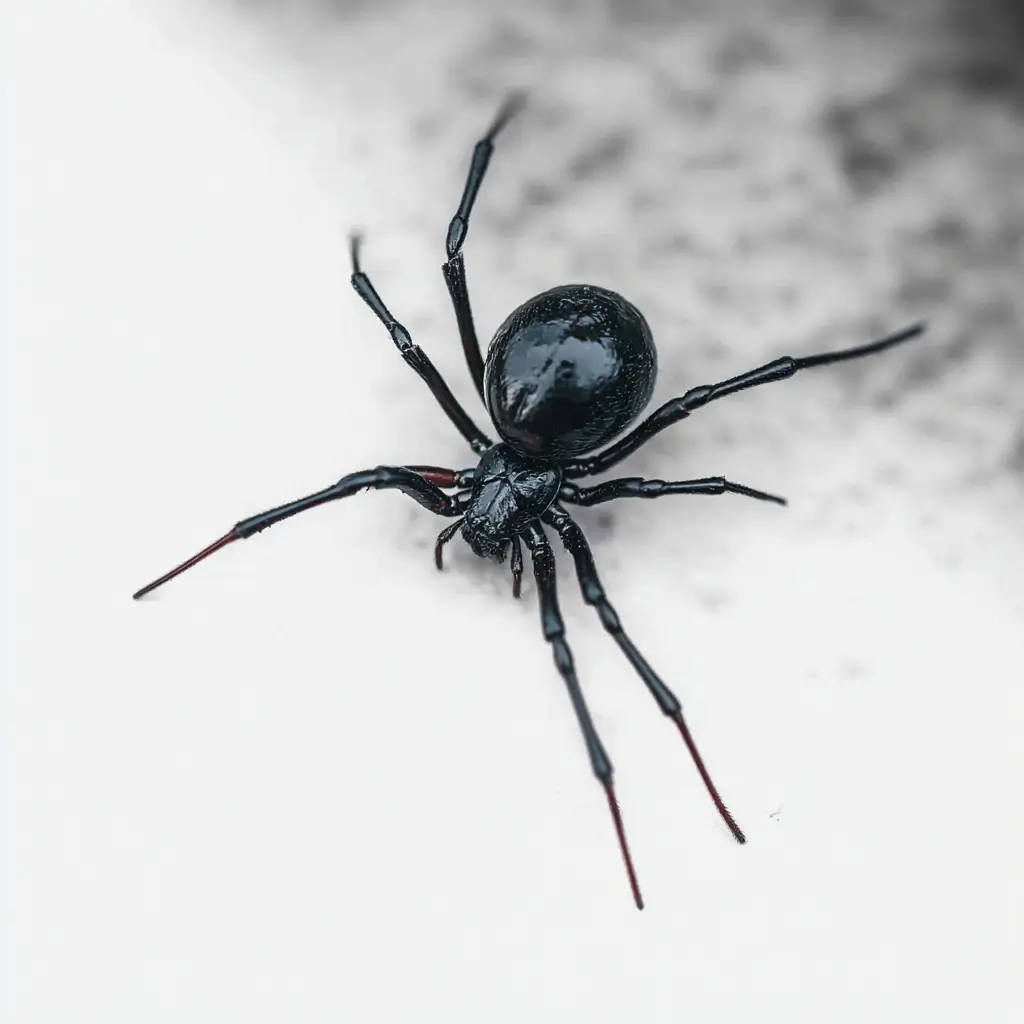
False Black Widow Spider
False black widow spiders are, as their name suggestions, usually mistaken for the much more dangerous black widow. And while they may look similar, they differ significantly in behavior, venom, and threat level.
At A-1 Pest Control, we help identify and manage false widow infestations so you can feel safe and confident in your home again.
Table of Contents
What Is a False Black Widow?

A false black widow is a spider that resembles the black widow in shape and size but doesn’t have the same dangerous venom. The term "false widow" refers to several species in the Steatoda genus, with Steatoda grossa being the most common false widow in the United States.
While it may look intimidating, the false widow does not pose the same level of danger as the black widow. That said, reactions to its bite can still be painful and should not be ignored.
False Widow vs. Black Widow: How to Tell the Difference
If you've spotted a spider in your home, knowing whether it's a false widow or a black widow can help ease your concerns. Here's how to tell the two apart:
Body Appearance
- False widow: Rounded, shiny body, usually dark brown or purplish. May have pale markings but lacks the distinctive hourglass shape.
- Black widow spider: Shiny black body with a bright red or orange hourglass marking on the underside of the abdomen.
Web Pattern
- Black widow: Builds irregular, tangled webs in dark, undisturbed areas like garages, basements, or crawl spaces.
- False widow: Also builds messy webs, but typically in more exposed areas, such as under furniture or around window frames.
Behavior and Bites
- Black widow: Aggressive when threatened. A bite may require medical attention and may cause severe symptoms in humans.
- False widow: More reclusive. Bites are rare and often compared to a wasp sting, causing mild to moderate discomfort for most people.
What Happens If You’re Bitten by a False Widow?
Getting bitten by a false widow usually results in symptoms similar to a wasp sting — localized pain, redness, and sometimes swelling. In rare times, symptoms may include muscle spasms or fever, but serious reactions are extremely uncommon.
If you think you've been bitten:
- Clean the area with soap and water.
- Apply a cold compress to reduce swelling.
- Seek medical advice if symptoms worsen.
Most false widow bites heal on their own within a few days without complications.
Where Are False Widow Spiders Found?
The false widow is a spider that thrives in quiet, undisturbed locations both in the home and outdoors. These spiders prefer environments that offer shelter, warmth, and a steady collection of prey, such as other small insects.
Indoors
Inside your home, false widow spiders typically hide in:
- Under-bed storage areas
- Behind kitchen appliances or laundry machines
- Inside closets, wardrobes, and cabinets
- Corners of garages, attics, or basements
- Under furniture, especially in low-traffic rooms
They often spin irregular, tangled webs and stay hidden during the day. Spider sightings are more likely at night when they become active.
Outdoors
Outside, false widow spiders tend to nest in areas that mimic their indoor hiding spots. These include:
- Sheds, barns, and crawl spaces
- Beneath garden furniture or grills
- In woodpiles or stacked firewood
- Along the eaves of the roof or under porch railings
- Inside hollow fencing or pipework
These locations offer both protection and an ample supply of insects, making them ideal habitats for widow spiders.
What to Watch For
If you're trying to determine whether you have a false widow issue, be on the lookout for:
- Sudden or repeated sightings of one or more small, round-bodied spiders
- Tangled or messy webs in quiet corners
- A noticeable rise in flying or crawling insects, which attract widows
- Egg sacs hidden along baseboards or tucked behind objects
As the widow spider population increases, you may begin to see more visible activity — especially during warmer times of the year.
Frequently Asked Questions
Are False Black Widow Spiders Dangerous?
While the false widow is often misunderstood, it’s far less dangerous than the black widow spider. However, it still produces venom, which it uses to subdue its prey. This venom is not usually harmful to humans, but sensitive individuals may experience stronger symptoms.
What Kills a False Widow Spider?
False widow spiders can be eliminated using targeted pest control treatments such as residual insecticides, aerosol sprays, or dusts applied to cracks, crevices, and known hiding spots. For long-term control, professional pest management—like the services offered by A-1 Pest Control—ensures safe, effective collection and prevention. Removing clutter, sealing entry points, and reducing insects (their food source) also help prevent future infestations.
How Can I Identify a False Black Widow Spider?
False black widow spiders (Steatoda spp.) are often mistaken for black widows due to their similar shape and color. They are typically dark brown to black, with a bulbous abdomen, and may have pale markings (e.g., cream, white, or reddish patterns) but lack the distinctive red hourglass of a true black widow. Their body size ranges from 5-10 mm (females) and 4-7 mm (males). Unlike black widows, their markings are less vivid and more varied, often forming bands or spots. If unsure, consult a pest control professional for accurate identification.
Where Are False Black Widow Spiders Commonly Found?
False black widows prefer dark, undisturbed areas such as basements, garages, sheds, or under furniture. Outdoors, they may inhabit woodpiles, garden debris, or under eaves. They build irregular, tangled webs close to the ground or in corners, often near their food source—insects. Check cluttered areas or poorly lit spaces in and around your home to spot their webs or hiding spots.
What Should I Do If I Find a False Black Widow Spider in My Home?
If you spot a false black widow, avoid handling it directly, as their bite may cause discomfort, especially for sensitive individuals. Use a jar or container to safely capture and release it outdoors if possible. For multiple spiders or suspected infestations, contact a professional pest control service like A-1 Pest Control to assess and treat the issue. Regularly clean and declutter your home, seal cracks, and install screens to prevent entry.
Can False Black Widow Spiders Bite Humans?
Yes, false black widows can bite if threatened or disturbed, but bites are rare and typically occur when the spider feels trapped (e.g., in clothing or bedding). The bite may cause mild to moderate symptoms like localized pain, redness, swelling, or itching, which usually resolve within a few days. In rare cases, sensitive individuals may experience nausea or muscle cramps. Clean the bite area with soap and water, apply a cold compress, and seek medical attention if symptoms persist or worsen.
How Can I Prevent False Black Widow Spiders in My Home?
To deter false black widows, reduce their food sources by controlling other insects with regular cleaning and pest treatments. Seal cracks, gaps, and entry points around windows, doors, and foundations. Keep outdoor areas free of debris, and store firewood away from the home. Regular vacuuming of corners, under furniture, and along baseboards can remove webs and egg sacs. For ongoing protection, schedule routine inspections with a professional pest control service.
Are False Black Widow Spiders Aggressive?
False black widows are not aggressive and prefer to avoid humans. They typically only bite in self-defense when accidentally touched or trapped. Their reclusive nature means they’re more likely to hide than confront people. If you see one, give it space and avoid disturbing its web to minimize any risk.
What Are the Signs of a False Black Widow Infestation?
Signs include multiple tangled, irregular webs in dark or undisturbed areas, such as corners, basements, or garages. You may also notice small, teardrop-shaped egg sacs (white or beige) in or near the webs. Frequent sightings of dark, bulbous spiders with pale markings could indicate a larger population. If you suspect an infestation, contact a professional pest control service for a thorough inspection and treatment plan.

